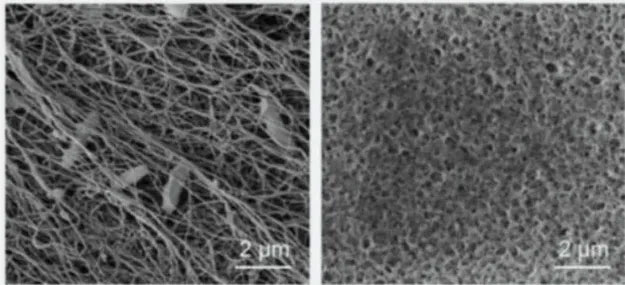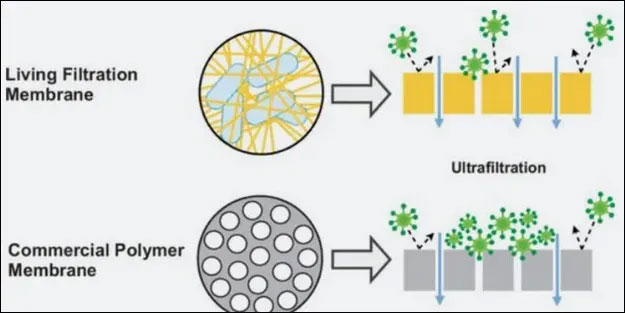Kombucha is a fermented beverage made from a SCOBY (Symbiotic Culture Of Bacteria and Yeast) – a type of yeast cultivated in sweetened tea (black or green tea). It is a fizzy drink with a mild acidity, commonly referred to as Kombucha tea. Recent studies indicate that SCOBY-based membranes are more effective than other commercial membranes in water filtration.
The article published in the ACS ES&T Water journal by the American Chemical Society states that Kombucha tea (currently regarded as a popular beverage among many people in countries around the world) is seen as a potential source for creating sustainable membranes for environmental water filtration at an affordable cost. Researchers at Montana Technological University (MTU) and Arizona State University (ASU) conducted experiments with membranes cultivated from Kombucha, demonstrating that they can better prevent biofilm formation – a mechanism that enhances water filtration – compared to current commercial membranes.
How is Kombucha Tea Made?
To make Kombucha, three basic ingredients are required: tea, sugar, and SCOBY (a symbiotic culture of bacteria and yeast). This fungus is also known as tea fungus, mother fungus, or Manchurian fungus (Kombucha tea is believed to have originated from Manchuria, China, or possibly Russia). SCOBY is a gel-like structure made up of cellulose fibers (biofilm) that is sturdy due to the presence of active bacteria in the cultivation environment, creating a perfect breeding ground for yeast and bacteria.
To achieve this sour beverage, you dissolve sugar in chlorine-free boiling water, then steep your chosen tea leaves in the hot sugar water, after which the tea leaves are discarded. Once the tea cools, you add the SCOBY and transfer everything into a sterilized jar or container, covering it with a paper towel or cheesecloth to prevent insects from getting in. After about 2-3 weeks, you will have a tea to sip daily. A layer of film forms on the surface of the liquid, technically considered a cell layer.
In Addition to Refreshing, Kombucha Has Proven Effective in Water Filtration
Known as a popular refreshing tea, Kombucha also promises to be used as a useful biomaterial. Last year, scientists at MIT and the Royal College of London created new types of “living materials” from SCOBY that could be used as biosensors. Notably, these materials can help purify water. However, researchers did not use wild yeasts typically found in Kombucha because these yeasts are difficult to genetically modify. Instead, they used a lab-grown yeast strain known as Saccharomyces cerevisiae (also known as brewer’s yeast). They combined the brewer’s yeast with a bacterium called Komagataeibacter rhaeticus (which can produce a lot of cellulose) to create the “mother” SCOBY.

Water filter made from Kombucha culture with live bacteria and yeast (left) shows better clog resistance compared to traditional membrane filters (right).
The research team continued to create cells in the yeast to produce enzymes that glow in the dark, particularly those that can detect and eliminate pollutants. One of the new prototype materials can recognize the presence of the pollutant estradiol, while another material can detect luciferase, a bioluminescent protein.
SCOBY-Based Membranes Outperform Commercial Membranes
Currently, an effective water filter based on SCOBY is entirely feasible. Statistics indicate that polluted water sources are linked to 2,000 child deaths globally every day. Water filters made from commercial polymer materials are compact and flexible, capable of removing many dangerous pollutants, including bacteria, parasites, and even some viruses.
However, the pores in these filters often become clogged over time, reducing filtration speed and water flow, leading to the accumulation of clay, oil, minerals, and bacterial biofilm – a type of accumulation that is particularly stubborn and difficult to remove once formed. Scientists are also developing materials and chemical treatment methods to prevent biofilm adhesion in filters. But a promising new strategy focuses on deploying materials that inhibit bacterial growth derived from Kombucha SCOBY.
Katherine Zodrow, an environmental engineer at MTU and a co-author of the study, conducted a 2020 experiment to demonstrate the feasibility of creating sustainable living filter membranes (LFMs) from bacterial cellulose networks and indigenous microorganisms from Kombucha SCOBY cultivation. The membrane was created similarly by placing SCOBY in a solution of sugar, black tea, and distilled white vinegar dissolved in deionized water.

Comparison of SCOBY-based membranes versus commercial membranes. SCOBY-based membranes prevent fouling more effectively.
They then placed the mixture in a controlled room to maintain a stable temperature for 10-12 days until a thick film formed on the surface of the mixture. These developed membranes were stored in deionized water and used in experiments within 8 days. For the experiments, the scientists collected about 20 liters of raw water samples from three drinking water treatment plants in Butte, Montana: Basin Creek Reservoir, Moulton Reservoir, and Big Hole River. These water samples were then pre-treated according to standard practices at each plant.
The researchers found that when filtering with standard LFMs and polymer-based filters, clogging occurred over time, causing them to flow and filter more slowly. The LFM filters used in the experiments demonstrated a filtering performance improvement of 19 to 40% compared to the aforementioned commercial filters, and the SCOBY-based filters also showed better abrasion resistance.
Zodrow and her colleagues also sequenced the DNA of any bacteria and yeast present in the SCOBY membrane and found that 97% of the bacteria belonged to the Acetobacter genus, which is dominant in Kombucha. The Acetobacter bacteria are notable for their ability to oxidize organic carbon sources such as sucrose, glucose, and ethanol into acetic acid (known for its antibacterial properties). Acetobacter has also been shown to reduce or even eliminate biofilm, which explains why the new LFMs perform so well against biofilms.

















































